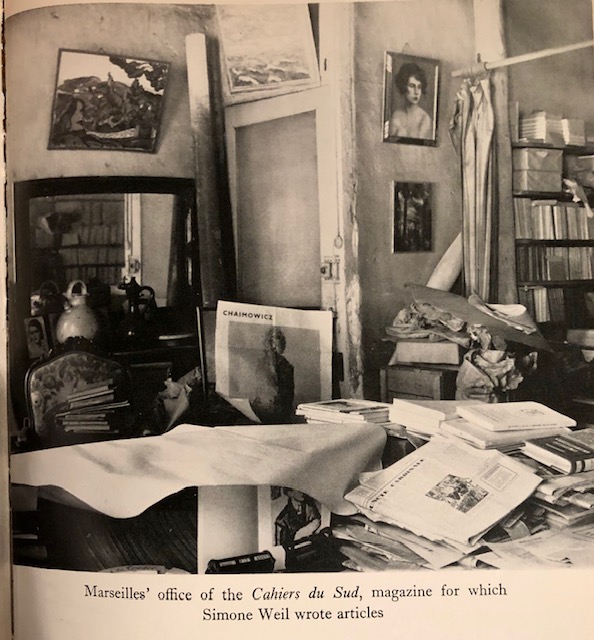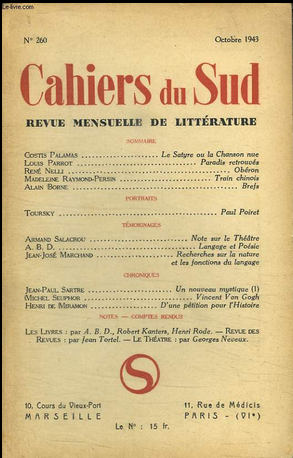Cahiers du Sud
Ronald KL Collins
The Cahiers du Sud . . . was often in trouble with the Vichy censors because of its ultraliberal views . . . . Its editors’ enthusiasm of her writing encouraged [Weil] to keep her journals far more faithfully than she ever had since her years of factory work. During her days in Marseilles she filled some twenty notebooks with material she wanted to incorporate into future essays . . . .
— Francine Du Plessix Gray
Simone Weil (2001)
Les Cahiers du Sud (“Southern Notebooks”) was a monthly French literary magazine based in Marseilles. It was founded by Jean Ballard (a French poet, author and editor) in 1925 and remained in circulation until 1966. Some of those who published in the magazine included: Gabriel Audisio, Walter Benjamin, Gaston Berger, Benjamin Fondane, René Nelli, Paul Valéry, Marguerite Yourcenar, and Simone Weil. Cahiers du Sud also published the poetry of Joë Bousquet, one of Weil’s close friends.
During her lifetime, Weil published some eight articles in Cahiers du Sud between late 1940 and 1943. Some of her most famous essays were published in the magazine, including “The Iliad or Poem of Force” (December 1940 with part II in January 1941). Weil contributed to a special issue of Cahiers du Sud dedicated to Languedoc and the life and persecution of the Cathars. Other writings, including some of her letters, were published posthumously in the magazine.

Of the magazine, Simone Pétrement has observed: It “was certainly the most important literary magazine in the free zone. Ballard, its editor-in-chief, was not afraid to publish Jewish writers and others who were known for their hostility to the Vichy government.” Initially, Weil submitted a poem (“A un jour”) but it was rejected. Thereafter, she “submitted no other poems, but she gave Ballard her article on the Iliad, since it was impossible to publish in Paris owing to the German invasion. Ballard accepted it with joy.” Simone Weil: A Life (1976, p. 393).
In her book Simone Weil: An Intellectual Biography (1989, pp. 190-191), Gabriella Fiori notes: Simone “would regularly visit Cahiers du Sud in its lofty editorial offices perched in an attic, with a secret door for escape in case of raids. . . . The review of Jean Ballard was . . . a welcome port for poets, artists and writers who for political or racial reasons sought a refuge in Marseilles or made it the last stop before leaving France for Algeria or America. . . .”
“Simone was brought there by Jean Lambert, who had known her through mutual friends at the time of the [Henri IV] Normale. It was Lambert [later André Gide’s son-in-law] who supported (at the request of Simone, who had entrusted the text to him) the publication of the important Weil essay [“The Iliad or Poem of Force”], which was already in galleys at Gallimard; ‘it was no longer wanted by the NRF [Nouvelle Revue Française], because it was unpublishable in the period of the German invasion.’”
“She would ordinarily sit in a chair of leatherette and wood, 1920 style, or in the corner of a shell-shaped sofa, loaded with books,” added Fiori. “The large stove rumbled hospitably. [The] poet Jean Tortel recalls that Simone always kept her hands in her pockets and looked beyond the others; she seemed not to be listening and then she would intervene with perfect pertinence or she would take up a point which had been left up in the air and hour earlier.”
Several of the articles and other materials listed below were signed under the male pseudonym of “Emile Novis” (a rough anagram of Simone Weil’s name, which seemed too obviously Jewish):
- “L’ Iliade ou le poème de la force” “The Iliad or Poem of Force”], vol. XIX (Dec. 1940) (part 1)
“L’ Iliade ou le poème de la force,” vol. XX (Jan. 1941) (part 2)
- “A propos des Jocistes,” [“About the Workers”], vol XIX (April 1941), pp. 245-246.
- “L’ Avenir de la science,” [“The Future of Science”], vol. XIX (April 1942), pp. 303-308.
- “La Philosophie” [“The Philosophy”], vol. XIX (May 1941), pp. 288-294
- “La Renaissance Romane” [“The Romanesque Renaissance”] 1941 or 1942
- “L’Agonie d’une civilisation vue à travers un poème épique,” [“The Agony of a Civilization Seen Through a Poem”], vol. XX (Oct. 1942), pp. 99-107, reprinted “Le Génie d’Oc et homme méditerranéen,” vol. XXI (special issue 1943) [“A Medieval Epic Poem”]
- “En quoi consiste l’ inspiration occitanienne?” [“What does Occidental inspiration consist of?” / also under the title “The Romanesque Renaissance”], vol. XX (Aug. 1942), pp. 150-158, reprinted in vol. XXI (1943) under the title “Le Génie d’Oc et l’homme” [“The Genie of Oc and Man”]
- “Réflexions à propos de la théorie des quanta” [“Reflections on Quantum Theory”], vol. XIX (Dec. 1942), pp. 102-119ie
Posthumous Essays & Poems
- “Sur le sentiment d’ éloignement” [“On the Feeling of Estrangement”] {not SW’s title}, vol. XX (1943)
- “Morale et Littérature” [“Morals and Literature”] {“Emile Novis,”}, vol. XX (Jan. 1944), pp. 40-45.
- “Nécessité” (poem) [“Necessity”], vol. XXVI (1947)
- “Éclair” (poem) [“Lightning”], vol. XXVI (1947)
Posthumous Published Letters
- Dec. 5, 1942: vol. XXVI (1947), pp. 567-570
- No date: vol. XXXII (1950)
- Mid-1941: vol. XXXIV (1951)
_______________________________
The above information concerning the materials published in the Cahiers du Sud was compiled from entries made in J.P. Little’s Simone Weil: A Bibliography (London: Grant and Cutler, 1973), pp. 15-27.
Additional French Sources
- Alain Paire, Chronique des Cahiers du Sud 1914–1966, Paris: iMeC, 1993.
- Les Cahiers du Sud / La génération de 1930, éd Garae/Hésiode, 1987, texte de Daniel Fabre,
- Nicolas Cendo et alii, Rivages des Origines: Archives des Cahiers du Sud, Marseille: Archives de la ville de Marseille, 1981, and
- Simone Weil Bibliography, University of Calgary


